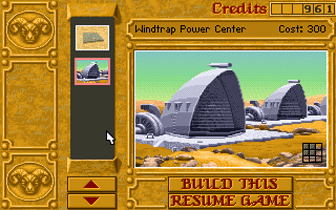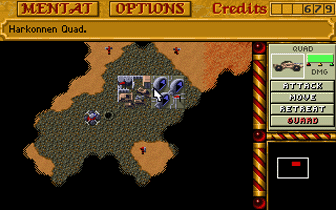OK, enough new games. It’s back to the 90s again with another game I mentioned in Cheat Codes for Life! This month, I’m reviewing the first recognizable real-time strategy game.
Certainly, there were strategy games before this one, and there were even a few real-time strategy games before this one. However, most n00bs would have trouble figuring out what to do with these games, as their only experience in the genre is likely StarCraft and WarCraft 3.
This game, on the other hand, has all the elements of the modern RTS. Gather resources to construct buildings that produce units; use these units to annihilate the enemy. All of the good stuff is there, yet the game was developed long before the first Command & Conquer or WarCraft.
Of course, the game I’m talking about is Dune II! Created by the same folks who developed Command & Conquer, the only thing this game has in common with the original Dune game is that it’s loosely based around the books by Frank Herbert. Ignoring the confusion over sequels and non-canon storylines, the game itself is inspired, well-planned, and a lot of fun.
For those not familiar with the Frank Herbert novels, this game’s story revolves around the battle for control of the planet Arakkis: the only place in the universe where the spice that allows for faster-than-light travel can be found. This is about as far as Westwood went in attempting to follow the original concept, but we are talking about the game, so if you really want to know more you can look it up yourself.
Three groups from different planets face off, each group with a slightly different selection from the same pool of units. This makes things interesting when you finally figure out that the Ordos really can’t make rocket launchers, or when you get to the last few stages in the Atreides campaign and get the sonic tank. While not quite the level of difference we’ve come to expect after games like StarCraft, this was a fairly novel concept back in ’92.
Other concepts that we generally take for granted, like fog of war and technology trees, were also relatively new at the time of Dune II’s production. There are a few ideas in this game that didn’t seem to stick, however. One is the sandworm. A roaming monster that tries to eat any units left on the open sands? A creative concept that definitely adds challenge to the game, but I can see why no other developers have tried to copy this. Another is building deterioration. Kind of like the sandworm, but for buildings. Because of the terrible conditions on the barren planet, your buildings slowly lose HP and will be easy for the enemies to destroy if you don’t repair them.
There are, however, a few things missing that players of modern RTS games could complain about. Most notably is the fact that only one unit can be selected at a time, and every command must be specifically issued. That is to say that, unlike most games in which multiple units may be selected, and all units commanded to take an appropriate action with a single click, you need to select the individual unit, click on the intended action, and choose a valid target.
This can be quite a problem. When you’ve amassed your grand battle fleet in front of your base and are looking to have them all attack the enemy, you have two choices. On one hand, you could tell them all to attack from where they are, scrolling all the way to the opposite side of the map and back for every unit, and have the attack look like a noobish Zergling rush, arriving and dying one-at-a-time. Your other option would be to (incredibly) slowly move every unit closer to the enemy base, and commencing the attack while everyone’s relatively close together.
It also doesn’t help that, if you click “Attack” and accidentally miss your target, your brilliant little unit will actually sit there and attack the ground until he either dies or the game ends. Oh, and if you have a unit attack an enemy while the two are across a building, your unit will have no problem with destroying the building first. This is especially fun if it happens on its own and you’re paying attention to other things, only to come back to find that half of your base is gone.
I have to give the programmers some slack, however. This game was conceived back in the days of DOS, in all its HIMEM glory. Advanced AI scripting, or even the processing and memory requirements to handle such a concept, was still a long way off. After all, the game limits unit and building creation on the sheer basis of preventing lag—which, while playing on my original 486DX, was still very common.
But, speaking of technology, the game did make use of some fairly new additions to the old computer machine. Aside from extended memory, Dune II also uses the mouse, although you could choose not to if you didn’t have one.
This wasn’t even the best part, however, as the game has—get this—SOUND! Not the usual beeps and bloops of the computer speaker, but real, digitized voice samples as we would come to expect today. Being able to hear notifications is a lot easier than trying to read them when you’re in the middle of a battle. My favorite has to be the screaming enemies, though, especially when you run over infantry using a tank. This game really set the bar for things to come.
The music is great, too. The developers succeeded to some degree in attempting a concept that many games still have trouble with today. The developers implemented contextual music that changes when certain things are happening. For example, the music will start out calm, but will build up if an enemy is approaching, and change to battle music once they’re engaged, slowing backing down into calm music after they’re defeated. A pretty sweet idea, not to mention that it sounds good.
As for graphics, the main portion of the game is in your average pixilated DOS goodness, although there is some pretty nice artwork for the unit and building descriptions. The game also features cutscenes to the best extent that DOS could allow. Not bad, although I’ve seen other games from the same timeframe that have similar graphics.
The replay value was exceptional then and is even pretty fair by today’s standards. With three houses to play there is much fun to be had by playing them all. The first play through can be quite challenging; though, after playing the game as many times as I have, I can easily beat a house’s campaign in a day. But, the fact that I’ve played the game so many times, even to this day, and I can still have fun with it says something about the game’s replay value. Either that or nostalgia, if my review of 7th Saga said anything about continuing to play bad games.
Anyway, overall, the game is amazing for the period in which it came out. It used a lot of new technology, and the developers came up with some great ideas that have become expected from RTS games these days. Unless you’re a masochist, however, I wouldn’t suggest that most people play it now for the first time. Getting used to the archaic command method and limited AI can only bring pain to those raised on games like StarCraft and WarCraft 3. But, hey, some people are into that kind of thing.



Oddly, the concept of the Sandworm was revisisted in later RTS games in the form of neutral units that attacked anyone who moved close to them!